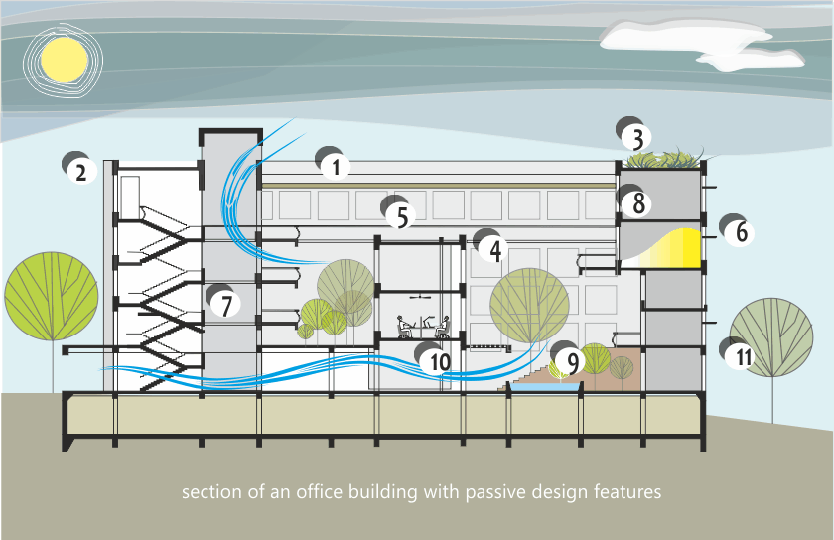
With the trend of the architectural world towards sustainability and energy efficiency, passive design can no longer be a compromised talent discipline among contemporary architects. The clients are more knowledgeable in 2025, the laws are becoming more strict, and their green certifications are becoming more attached to the price of the property. This causes passive design not only as a design philosophy, but a competitive edge. Using the centrality of the natural movement of the energy, i.e., sunlight, airflow, and thermal mass, the architects can minimize the use of mechanical systems and make the buildings healthier, cost-efficient, and environmentally conscious.
Passive strategies are creative and technical knowledge. Every decision, whether it is orientation and shading or insulation and material choice, has a long-term energy performance solution. With the improved design technology, there is also the use of digital tools to simulate and optimize passive results in the conceptual phases by the architects. It is at this point that the Best Monitor For Architects may be used to increase precision and accuracy, particularly where complicated 3D energy-modeling settings are involved.
The future of sustainable living is in the passive design technologies every architect ought to know in 2025: let us discuss them now.
1. The best Building Orientation on Sun and Wind.
Passive design is built on the basis of building orientation. Effective orientation enables architects to ensure that they make the most out of natural sunbeams in the winter months and the least in summer months. In the majority of places, it is advisable to have the long side of the building face south (on the Northern Hemisphere) so that the daylight can be uniform and manageable.
The main advantages of proper orientation are:
- Less artificial lighting requirements.
- Better indoor thermal comfort.
- Reduced heating and cooling energy requirements.
The direction of wind is also significant. Determining the common wind patterns will enable an optimal positioning of openings, windows, and courtyards to promote natural ventilation. Through effective channeling of breezes, buildings would not need to be very dependent on HVAC systems to keep them cool.
2. Sun Control and Strategic Shading.
Shading devices are necessary in passive temperature control. This is because with the increasing extremes of climate conditions, architects need to come up with shading systems that can adjust to the seasonal variations.
The use of common shading elements:
- Overhangs and awnings
- Vertical fins and louvers
- Pergolas and trellises
- Landscaping (trees and vines, green screens).
External shading in hot climates may cut down cooling loads significantly. Occupants can control daylight and privacy during the day by having responsive shading, including adjustable louvers. The advent of new materials such as photochromic glass and solar louvers has given architects new tools on how to develop shading systems that will be useful and attractive.
3. Thermal Envelope Design and High-Performance Insulation.
The technology of insulation has changed greatly by the year 2025. Architects now get a wider range of choices than ever before in the design of a strong thermal envelope, starting with vacuum-insulated panels and phase-change materials.
The heavy envelope regulates heat gain and loss between the interiors and exterior and ensures that the temperatures are constant with little mechanical interference.
Key components include:
- Wall and roof insulation
- Windows and doors with airtight seals.
- High-performance glazing
- Mitigation of thermal bridging.
- Insulated foundations
Passive performance is further improved with the use of thermal mass, which is the material that absorbs, retains, and releases heat. One can moderate the temperature indoors using concrete, brick, and rammed earth by absorbing the heat in the day and releasing the heat at night.
4. Cross-Flow Air Movement and Natural Ventilation.
Passive ventilation is efficient in minimizing air conditioning and enhancing indoor air quality. The concept of cross-ventilation is to place the openings on different sides of a room to create the natural flow of air.
Architects should consider:
- Window placement and size
- Ventilation shafts
- Open-plan layouts
- Stack ventilation areas that are doubled in height.
- Courtyards and atriums which serve as natural air channels.
The stack effect ventilation is especially strong in multi-story buildings, where the natural inclination of warm air to rise is exploited to produce motion without the aid of mechanical means.
5. Passive Solar cooling and heating method.
Passive solar design utilizes solar energy to cool and heat buildings without the use of mechanical cooling and heating. South-facing windows combined with thermal mass may greatly lower heating loads in cooler climates.
Passive solar heating measures:
- The south-facing, large, and well-insulated windows.
- Dark flooring that is heat-absorbing.
- Heat storage trombe walls.
- Optimal solar heat gain coefficient glazing.
In passive cooling, shaded courtyards, light colored roof coverings, and berming of earth curbate heat absorption, particularly during the hottest seasons.
6. Intelligent Material Choice to save on energy.
The choice of materials has a direct impact on the capacity of a building to be comfortable all through the year. By 2025, environmental stimulated smart materials became a common architectural element.
Examples include:
- Glass which changes its color depending on temperature.
- Lightweight high-performance insulation aerogels.
- Hempcrete to breathable carbon-negative walls.
- Insulation and cooling with green roofs and green walls.
Such materials can improve passive design performance, as well as making the buildings healthier and more sustainable.
7. Incorporation of Daylighting to Productivity and Wellness.
Daylighting does not only focus on bright interiors, but it is a science that has its effects on mood, productivity, and energy use. The architects need to know how to implement the use of the clerestory windows, skylights, light shelves, and reflective surfaces to balance the natural light and minimize the incidence of glare.
Early daylight modeling during the design period can enable the architects to know areas of possible problems and to optimize the placement. In this case, also, the correct design tools used on the Best Monitor For Architects will guarantee accuracy, particularly in the high-level analysis of light simulations as well as high-level renderings.
8. The inclusion of Landscape and Microclimate Design.
Passive architecture involves landscape design. Trees, shrubs, water features, and landscape may make a great impact on the internal climate of a building.
Good landscape strategies entail:
- Seasonal shading on deciduous trees.
- Evaporative cooling water bodies.
- Thermally stable areas covered with earth.
- Wind corridors that are green.
It is through the knowledge of the microclimates that architects can create buildings in harmony with nature and not in conflict with it.
Conclusion
Passive design has ceased to be a choice and has become the future in architecture. The most successful architects will be those who will learn to master the use of energy-efficient strategies in building comfortable and resilient, environmentally conscious spaces in the year 2025. Since building orientation to material innovation, every passive technique adds up to a building that is highly performing in terms of operational costs.
In the case of architects dealing with detailed simulations, models, and visual analyses, the purchase of the Best Monitor For Architects would be extremely effective in improving accuracy in design. Passive design will always stay at the center of progressive and sustainable architecture since the industry keeps developing.
Author Profile
Latest entries
 NCAAFDecember 14, 2025Heartbreak in Baltimore: Navy Rallies to Edge Army 17-16 in Commander-in-Chief Thriller
NCAAFDecember 14, 2025Heartbreak in Baltimore: Navy Rallies to Edge Army 17-16 in Commander-in-Chief Thriller NFCDecember 13, 2025NFC Playoff Picture: The West Coast Showdown and the Tightest South Ever
NFCDecember 13, 2025NFC Playoff Picture: The West Coast Showdown and the Tightest South Ever AFCDecember 13, 2025AFC Playoff Picture: The Wild West and the Race for the Top Seed
AFCDecember 13, 2025AFC Playoff Picture: The Wild West and the Race for the Top Seed NFLDecember 13, 2025The Un-Retirement: Philip Rivers Puts Canton on Hold for Playoff Run
NFLDecember 13, 2025The Un-Retirement: Philip Rivers Puts Canton on Hold for Playoff Run

 Steelersforever.org
Steelersforever.org





